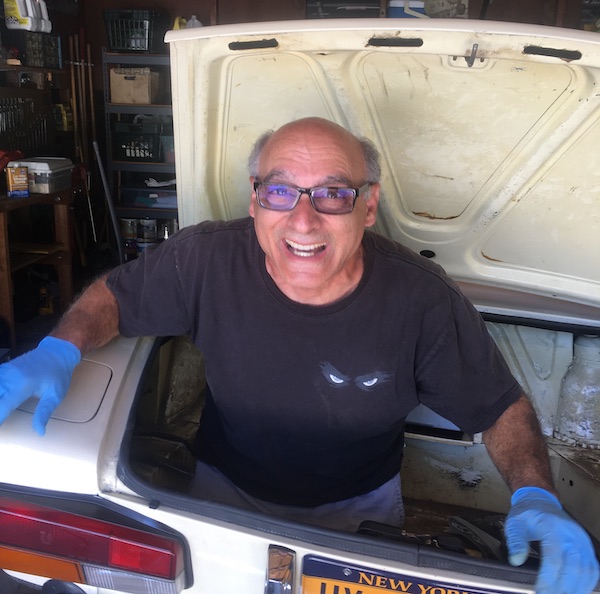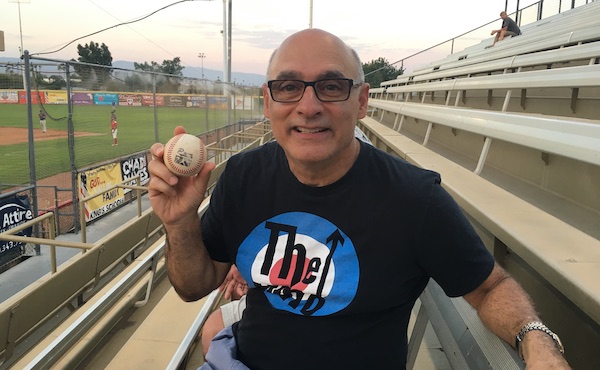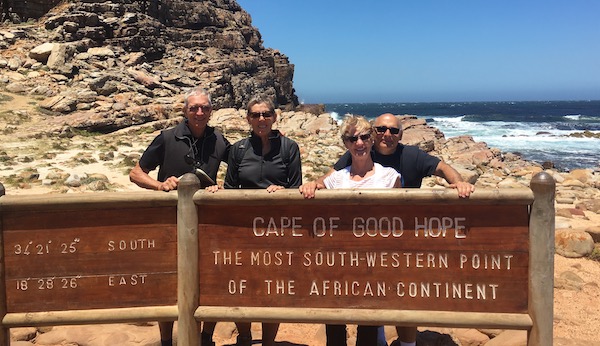
For this post, I’m featuring an interview with Larry Bakerjian, whom all of you know as the founder of Asset Strategies. Larry’s career as a financial planner spanned more than 40 years. I’m asked so often how Larry and Roxane are doing I thought it would be fun to have him tell us himself.
Adam Hartrum: Larry, what have you been up to?
Larry Bakerjian: Well, there are pre and post-COVID-19 answers to that. Before the pandemic, Rox and I started to travel.
Our best trips were the four Formula One races we attended. We also saw vintage Formula One cars in Sonoma in 2018 and Wisconsin last year. That is really fun because they were cars from the late ’60s and early ’70s when I fell in love with the sport. So, to see them up close, to literally touch them and talk to the mechanics who take care of them, was just awesome. If you’d told me in 1972 that one day I’d be that close to those cars I’d never have believed it.
We also did trips within the U.S. Our son lived in Montana during 2018 so we went up there to see him and visited Mt. Rushmore, Deadwood and The Little Big Horn. And, we met our friends Jan and Rich, who were almost at the end of their 16-year circumnavigation aboard their 41-foot sailboat, Slip Away. We hung out with them for five days and had a blast.
My brother, Stephen, and I took a trip to the east coast to visit our cousins. It was fun seeing that branch of the family and spending time with Stephen one on one. We don’t get to do that very often.
And of course there is racquetball. My friend Terry and I continue to go at it. At least we did until COVID shut us down.
Since the pandemic, we have laid pretty low. Lots of yard work and house projects but not much else. I’m not a very good carpenter but have had an opportunity to improve while repairing the deck behind my house. I’ve also been doing repairs to the stone walls and planters.
My nephew has a 1980 Fiat, and he’s been over several times and we work on it together. That takes me back to my late teens and early 20s when I owned sports cars and used to work on them all the time. The best part is when we’re done he buys me pizza.

Adam: What do you miss about work?
Larry: There definitely are things I miss. For sure, the social interaction of seeing clients every day is a big one. And having to be “on” is something I miss as well. I really enjoyed working because it kept me at a high level of engagement. Now, life is slower and in a lot of ways that’s really nice, but in another way I do miss being fully engaged day to day.
Adam: Do you think much about markets and investing?
Larry: For sure the week-to-week, month-to-month stuff is not something I think much about. One thing I have enjoyed is reflecting on my career. Time away has given me a perspective that was hard to gain when I was “in the arena,” to borrow Theodore Roosevelt’s words.
Adam: Where do those reflections take you?
Larry: My training came from both book learning and the day-to-day experience of being responsible for guiding clients’ financial lives. As you might guess, the book learning was the easy part. Our business isn’t rocket science. It’s learning tax law, investment theory, how different mutual funds are managed and so on, and applying the lessons to each client’s best interests.
But experience could only come with time. It came from good times and bad, from seeing what worked and what didn’t. And sometimes from getting kicked in the teeth.
You can’t buy experience. You just have to last long enough to gain it. And when you do gain it, you need to be wise enough to use it advantageously.
Adam: How about since you retired? Have you gained new perspectives?
Larry: I’ve had about three years in the role of a retired person, and they have added to the pool of experience I can draw from. For sure, I identify with the people I worked with who are retired. It’s easier to see things through their eyes.
Adam: Looking back, what do you know now about investing that you didn’t in your 20s when you were just starting out?
Larry: When I started, like most people in the profession, I thought it was all about being in good mutual funds, or having your allocations just right, and so on. It was the numbers that would make or break you, and if you were good at the numbers you’d be successful.
But it turns out that’s not what makes the difference between investing successfully, or not. The most important lesson learned in all my years as an advisor is that individual behavior is, by far, the most important factor in how a person fares financially. It’s as simple as that.

Adam: What exactly do you mean?
Larry: Study after study shows that most investors don’t get the returns the market provides. You can Google it. Type in “investor returns versus market returns” and have a look. You’ll be surprised at what you see. Most investors have returns lower than the markets earn.
How can that be? It sounds like mumbo-jumbo. Shouldn’t an investor in, say, a fund that mirrors the S&P 500 Index* get the same returns as the index itself, less maybe a fraction for expenses?
Yes, they should, but they hardly ever do. Why? Because most investors allow their emotions to guide them when history tells us over and over not to do that.
Adam: I’ve seen those same studies. That hasn’t changed, has it?
Larry: No, not a bit. Look at the market just this year with the pandemic. They’ve gone through a shock. In February, as COVID-19 began to take hold across the globe, markets reacted with sharp drops.
In March, the virus hit the United States hard. Stay-at-home orders were put in place and the economy pretty much shut down. It was hard to see a scenario where life would return to normal soon, and even harder to make a case for stocks to rally in the short term. The urge to “do something” grew for many investors, especially those who manage their own accounts.
It seemed perfectly logical to move out of stocks, wait until things improved and then move back in again. Logic is good, right? How could being cautious during a global crisis be a bad thing?
So, many investors moved out of stocks. They acted with the best of intentions, guided by what they thought was careful thinking. In truth, it was a decision driven not by logic but by emotion.
And the interesting thing is, it doesn’t have anything to do with how smart you are or how successful you are. In fact — and this is crazy to say — sometimes people can be too smart for their own good. Their brains react to their emotions and tell them they need to get out of the market, and so they do.
As we speak coming into mid-August, coming out of the market was a mistake. A big one.
Adam: We’ve seen this before.
Larry: You’re totally right, Adam. The bursting of the tech bubble in March of 2000. The market decline of 2000-02. The financial crisis of 2008. It’s history repeating itself.
Individual behavior is, by far, the most important factor in how a person fares financially.
Adam: What’s wrong with trying to come out of the market and then getting back in when things are better?
Larry: It’s just so hard to do effectively. If we KNEW when the market was going to peak, then hit bottom, then start to rise again, we’d all be rich because we could always do the right thing. But we don’t know that. Nobody does. Can you name any investment professionals, people who spend their lives immersed in markets, who do this successfully time after time? I can tell you how many I am aware of. None.
Instead, coming out and moving back in often causes a lot of damage, because the timing is so bad. That’s because markets tend to rally when there’s no evidence or reason for their doing so.
We’re still in the midst of this pandemic. There’s no way to know what markets will do in upcoming months while we wrestle with getting the virus under control.
But we do know that after dropping from mid-February and into March, the markets rallied suddenly, strongly and most unexpectedly.
There was a fascinating article in the July 3, 2020, issue of the Los Angeles Times that discussed this phenomenon. The article says the S&P 500 Index was nearly flat for the year as of that date. Anyone who had money in the Index on January 1st, and who was still invested on the Fourth of July, had essentially flat results, too.
Adam: But it wasn’t a smooth ride.
Larry: That’s right. Investing hardly ever is. Bumpy rides are part of the process. History shows us that over and over again, right up to and including the COVID-19 crisis.
I said a minute ago that markets got hit hard from February into March. But from its bottom in March, the Index rallied 40% by the Fourth of July, the Times says.
At what point between market bottom and the Fourth of July did the investor who got out — because they had to “do something” — feel that it was safe to get back in? Was it after the market had climbed 10%? 20%? Or, because the pandemic was still in full bloom, were those just false dawns? Was it better to wait for another fall before getting back in?
It turns out that if you had waited, you would have watched the market go up, back to its former high. You would have sold low and bought high, the opposite of success.
During March, the Index dropped more than 5% on five different days. It was down 25% over only 5 days. If only we could have avoided those five days!
On the flip side, two different days saw rallies of 9% each. A return of 9% would be considered a good year and the market did that on two separate days. The last thing we’d want to do is miss days like that!
When you look at data like that you start to see why it’s so hard to time the markets. And you see how getting it wrong can hurt you in the long term.

Adam: What’s the bottom line?
Larry: According to the Times article, an investor who missed the best five days during the rally from March’s market bottom was far from being even by the Fourth of July. In fact, they would be down about 30% for the year at that point. Five missed days was the difference between being even and being down 30%.
All of this is why I say that investor behavior, more than anything else, determines how well a person does.
This also illustrates something I incorporated into my practice: Never put yourself in a position where you have to make a big decision.
If I made five or six little decisions and one of them didn’t turn out well, it wasn’t a big hurt to a client. But, if I had to make only two decisions and one of them didn’t go well, it would likely have had a significant negative impact for the client.
Adam: Selling stocks is a big decision.
Larry: It is. But worse, selling puts you in a position of having to make another big decision — when to get back in. Get either of them wrong and likely your portfolio will suffer greatly. The more big decisions you make, the more likely one will be wrong.
Adam: Is there a way to help manage your emotions, to keep them in check so you don’t feel a need to change your long-term investments?
Larry: When I was in my 30s and 40s, we’re talking 30 to 35 years ago, I was aghast if a client told me they had large sums of money in the bank earning almost nothing. All of my book learning told me that the proper amount of money to have in reserve was between six to 12 months of expenses. If it took $5,000 a month to run your show, you should have $30,000 to $60,000 in reserve. Why keep more than that in a low-yielding account?
As I gained more experience, I realized that large sums of money in a bank or money market gives clients something very important. The warm fuzzies.
Someone with a year’s worth of expenses tucked away can put aside scary stock market news and avoid a “big decision.” Someone with two years of expenses could ignore such news. With even more than that, they’d say, “What news? I’m not paying attention at all.”
Never put yourself in a position where you have to make a big decision.
Adam: Are you following your own advice?
Larry: After four decades of socking money away, I am relying on what I have for income now and for the rest of my and Rox’s lives.
I had always been my own advisor, and I practiced what I preached. I also was fairly heavily allocated to stock funds, because over time those funds provided better returns than more conservative funds.
In late 2017, you, Rox and I took a fresh look at our investments. You suggested we scale back the portion allocated to higher risk investments and build up our cash reserves. Now we’re allocated in a way that suits our situation with money in reserve so that if something comes up we don’t need to touch our long-term investments.
Remember, I’m the guy who practiced what he preached. I did not look at my own investments day to day, week to week or even month to month. With that history, I’ve been struck by how little I’ve been concerned during the February/March market downturn.
The moral of the story is to always remember the reasons you’re invested. Don’t let bad behavior derail you. Have money in reserve so you can ride through rough times.
Adam: So much is about perspective and keeping your wits about you, isn’t it?
Larry: Yes, absolutely. If you’re a baseball fan you may remember Sparky Anderson. He managed the Cincinnati Reds and the Detroit Tigers to World Series wins. He was a great manager, a guy really good at what he did.
I heard him say that no manager ever got a big hit to win a game or threw a big pitch to strike someone out. The key to being a successful manager, he said, was to get your ball club into the position where, by the 8th or 9th inning, if a player did get a big hit or record a big strikeout, it mattered. It didn’t happen when it was 10-2 in the 9th inning, it happened when it was 3-2 and made a difference in the game.
I used to think of that quote a lot when I was an advisor. The job we do for clients has a lot of parallels to managing a baseball team.
Adam: Thanks for catching us up on what you’ve been doing and for your comments on investing.
Larry: Oh, thanks for inviting me to do this. I really enjoy talking about our business and am glad to do it anytime.
Adam: If you have concerns about how you’re positioned to meet the challenges we face please let me know. I am always ready and available to discuss any questions or concerns you may have.

Adam Hartrum
South Bay Asset Strategies
*The S&P 500 (Standard & Poor’s 500) is an unmanaged group of securities considered to be representative of the stock market in general. The index cannot be purchased directly by investors. Past performance is no guarantee of future results.
Investors should consider the investment objectives, risk, charges and expenses of the mutual fund carefully before investing. The prospectuses and, if available, the summary prospectuses contain this and other important information about the mutual fund. You can obtain prospectuses and summary prospectuses from your financial representative. Read carefully before investing.
Adam Hartrum is a registered representative with, and securities and advisory services offered through, LPL Financial, a Registered Investment Advisor, Member. The opinions voiced in this material are for general information only and are not intended to provide specific advice or recommendations for any individual. All performance referenced is historical and is no guarantee of future results. All indices are unmanaged and may not be invested into directly. Stock investing involves risk including loss of principal. The economic forecasts set forth in this material may not develop as predicted and there can be no guarantee that strategies promoted will be successful.

